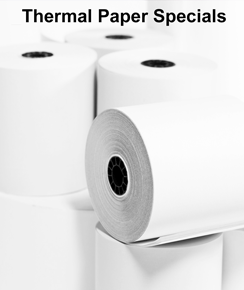How Does Receipt Paper Work?
Receipts have become ubiquitous in our everyday lives as we power through our hectic routines. From grocery stores to schools, from restaurants to cinemas, receipts are the evidence of all transactions that take place.
Despite being omnipresent, people seldom understand how receipts work and how they are made. Understanding how the receipt world works really helps if you are planning on launching your own business and want to understand which types of receipts you should make. While digital receipts are gaining traction over the globe, receipts will still be paramount in business activities.
Here, we have put together everything worthwhile knowing about how receipts work, how and what they are made of, and what their eventual destination should be.
What are the different types of receipt paper?
The first step in understanding how receipts work is by looking at their composition. There are three main categories of receipts:
- Thermal Paper Receipts: Thermal paper receipts are perhaps the most common type of receipts and work by generating prints through the application of heat from thermal printheads. They contain chemicals and dyes which are sensitive to the application of heat to generate prints.
- Bond Paper: Bond Paper is high quality paper that is suitable for printing in office machines including copiers and desktop printers. The main characteristics of bond paper include erasability, excellent absorption, and rigidity. It derives its name from government bonds, since it was traditionally used for all such documentation. Although it is a strong and durable paper, it is lightweight.
- Carbonless Receipt Papers: Carbonless copy paper or no carbon requirement (NCR) as the name suggests has completely removed the need for a carbon sheet in between copies. Carbon paper was not only messy but it also posed a security risk. Carbonless copy paper, on the other hand, allows users to create multiform copies with very less pressure.
Out of these three receipt papers, thermal papers are most commonly used for receipts. Owing to their ease of use, convenience, wide availability and lower cost, a huge chunk of the industries over the globe make use of thermal paper.
Hence, below, you can find details on how thermal paper works.
How does Thermal Paper work?
As the name suggests, the main science behind how thermal papers work is through the application of heat to generate prints. Thermal papers work without ink, ribbons or toners. The thermal paper features heat sensitive pigments which are activated once the thermal printer applies no pins on the paper. The prints only appear where the printer has inserted the hot pins on the receipt paper where receipt details are formed.
One of the biggest benefits of using thermal papers is that they are economical to use and do not require inventories to be held. This kind of receipt paper also does not require expensive ink or cartridges to get the printing done. Thermal papers are also generally smoother and shinier.
If you want to identify a thermal paper, the easiest way is to scratch the surface. If a black line appears, you have located a thermal paper. The line is formed from the heat generated from your fingernail as you scratch the surface.
How does thermal paper generate imprints?
Since thermal paper does not use any ink, the brain begs the question, how does thermal paper generate imprints? Thermal papers contain color developers which react with latent ink pigments on the application of heat to produce imprints.
The most common color developers contained in thermal paper are BPA and BPS. BPA and BPS are quite well-known since these chemicals are potent color developers.
To learn more about thermal paper receipts, toggle to our article:
What is Thermal Paper and How to Use it?
How does bond paper work?
In order to generate prints on bond paper, one needs to use traditional desktop printers and copiers which are commonly available at businesses and offices. It usually has a high content of cotton fiber which gives it a thicker and more substantial texture.
High-quality bond paper is made from anything ranging between 20% to 100% of cotton rag fiber, which makes the paper durable. This type of paper is stronger than paper that is made solely from wood pulp.
It is often sold in the same dimensions as most other papers.
How Does Carbonless Receipt Paper Work?
Carbonless Receipt Paper works best if you are looking to create multiple copies of the receipt at one point in time. The front copy is a traditional paper with a coated back while the duplicate copy is coated both front and copy to allow for multiple copies to be created.
The imprints from carbonless receipt paper are created as a result of pressure. As the printing process applies pressure on the front copy, the duplicate copy is created as a result of the back coating releasing crushed microcapsules.
Which receipt paper should you choose?
It can be a bit confusing to navigate through these different types of receipt papers and choose the one that works best for you. Below, you can find a table outlining the salient features of all three types of receipt paper.
|
Feature |
Thermal Paper |
Bond Paper |
Carbonless Paper |
|
Colors |
Comes in white |
Comes in white |
White and multiple other colors |
|
Coating |
Has coating |
No coating |
Has coating |
|
Main use |
Thermal printers |
Copiers and Desktop printers |
Laser printers |
With this easy to understand chart outlining the main features of all three types of receipt paper, you can weigh the factors and decide which category works best for you and your business.
But if you want to remain on the safe side and pick a receipt paper that is well established, we would suggest that you get your hands on thermal paper rolls.



